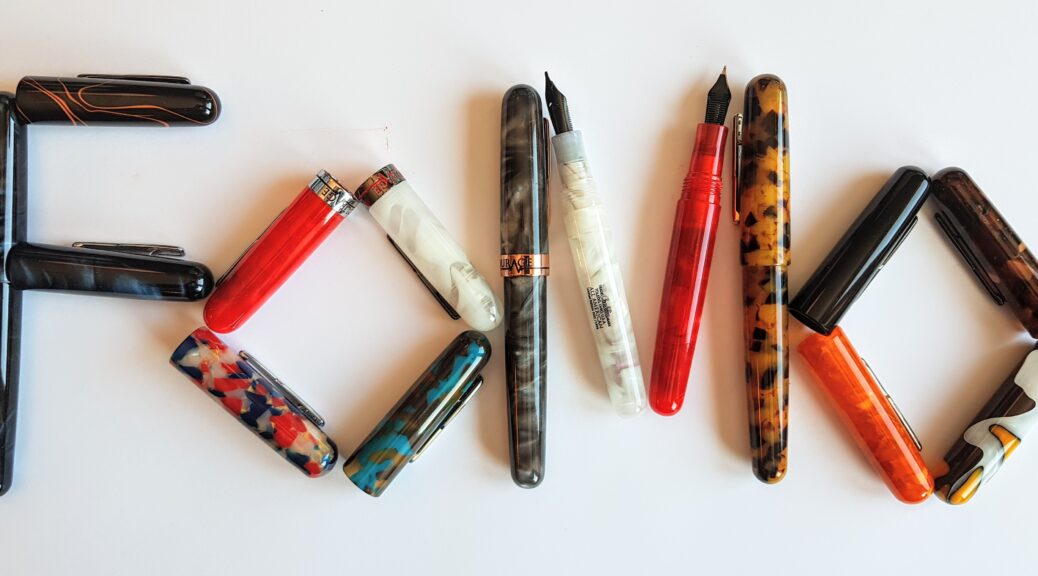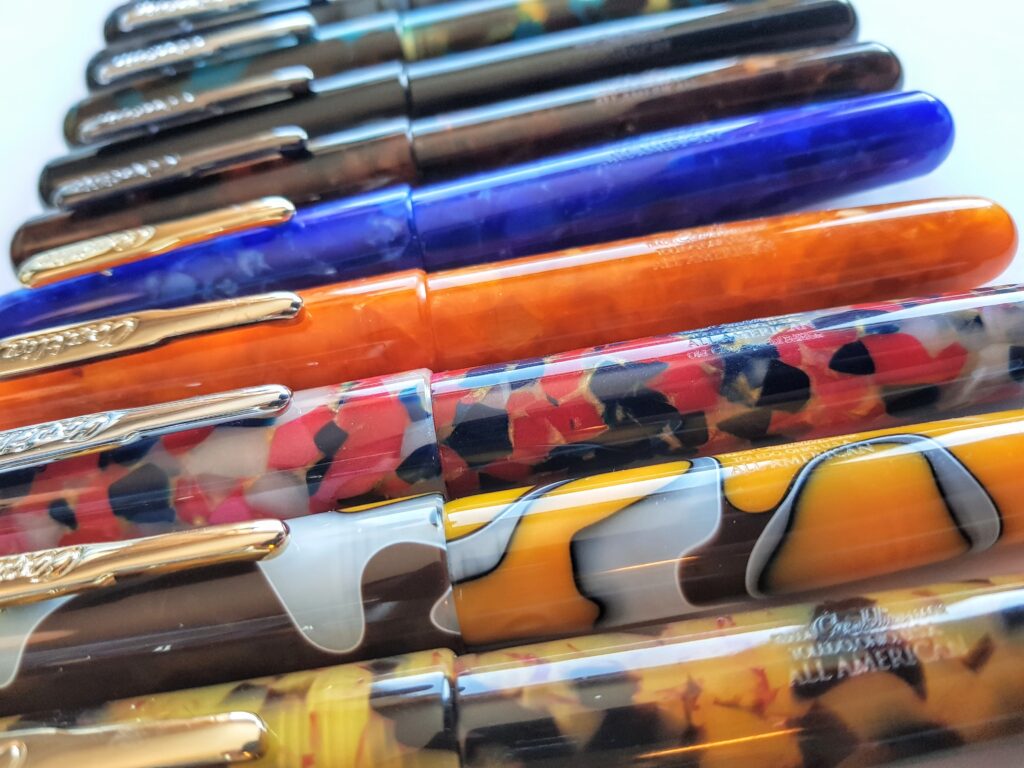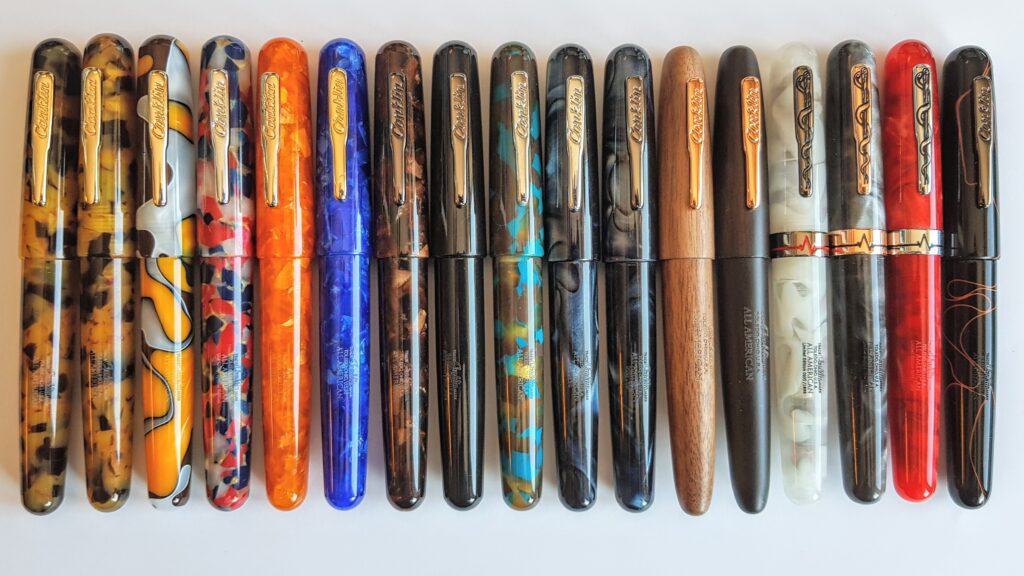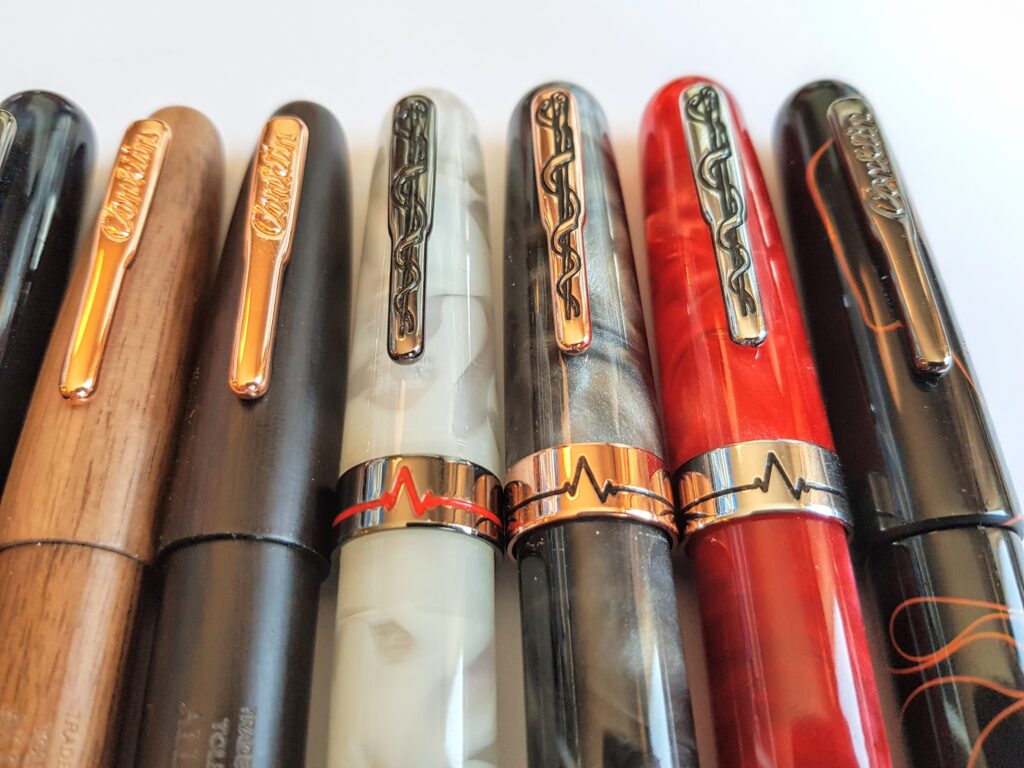
The fear of missing out, and why I stopped collecting the Conklin All American
This blog post was originally published in Norwegian at Pennen er mektigere, on March 14, 2021.
FOMO – The Fear of Missing Out, is a term that’s used in many contexts, including by many in the fountain pen community. But what is FOMO? Why do we feel FOMO, and how is this fear exploited by the market? We will take a closer look at that in this blog post.
This phenomenon was first described by Dr. Dan Herman in a scientific article titled “The Journal of Brand Management” in 2000, but the term was coined by Patrick J. McGinnis four years later, in the Harvard magazine “The Harbus”. FOMO was initially used to describe a form of addiction to social media. A fear that you would miss something if you didn’t continue to scroll through a perpetual stream of news and status updates; a fear of not being included. In recent years, the term FOMO has also often been used in other contexts, including in collectors’ circles, and there are probably many fountain pen enthusiasts out there who’ve felt this fear when a new special edition of a pen has been released in limited numbers: “I have to hurry up and order this pen before it sells out!”
In this context, FOMO forces people to impulse buy. Many people are so afraid of missing out on the latest edition of what they collect that they just have to order as soon as the product is launched, without thinking through whether they actually need this item, or for that matter whether they can afford to buy it. Critical thinking is replaced by an almost panicky fear of not being able to complete one’s collection.
Science has no clear answer as to why people like to collect things, but it’s a fact that many of us find great joy and comfort in collecting. The vast majority of people collect something at one time or another during their lives. There’s something about finding new items to incorporate into your collection that feels very satisfying. There’s also to a certain extent a need for completion, and a feeling of satisfaction when you have a complete collection.
Thus, we’re also overjoyed every time something new comes on the market that fits into our collection, for example a new edition of the Lamy Safari, TWSBI Eco, Pelikan Souverän, or as it was in my case: the Conklin All American.

Today’s market is not adapted to products that last a lifetime. On the contrary, most things we buy wear out after a few years, and in many cases it will be more affordable to buy new than to try to get it repaired. This also means that many of those who make things don’t even offer to repair it when something has broken. Rather, they make money by constantly selling new things. The cell phone companies probably wouldn’t have made as much profit if it weren’t for the fact that people mostly have to replace their phones after just a few years.
For those who make fountain pens, things are a little different, as much of the appeal is that the pen should last a long time. Preferably for life. In other words, their customers are not motivated to buy a new pen because the old one is worn out. Manufacturers have to find other ways, then, to motivate their customers to keep buying.
The fountain pen market is also relatively small, and there are many brands fighting for the same customers. How do you make money when your product never wears out and people never really need to buy a new one? Well, you make a whole bunch of special editions and appeal to collectors. That way, you sell a lot of new pens, even though people have more than enough pens already.
The result is in many ways a win-win situation, but also a kind of dilemma. The pen factories make money that they can use to develop new pens, and pen enthusiasts are constantly getting new editions to add to their collection, as long as their wallets are big enough. Both parties are happy, and neither wants this to change. Win-win, right? Or is it really?
This strategy also exploits people’s weaknesses. When you have been in this hobby for a while, you have eventually heard a few stories about people who, without thinking about it, have spent much more money than they could really afford on fountain pens. For some it becomes almost an obsession. For long periods, they spend far beyond their means, and put themselves in debt to be able to buy the pens they want. Pens that are only available for a short time, because they are special editions.
Of course, it’s not the responsibility of the pen factories that people aren’t able to manage their own finances, but they definitely encourage this behaviour, and create a kind of dependency, where the consumer no longer feel that they have any choice. This is a must have product.
I know that I have felt like this. You’ve decided that you collect a specific pen, and then you feel almost obligated to buy every new edition that comes out. It’s probably manageable enough if there’s one new edition a year, but in recent years several of the most popular pens to collect have come with three, four and five new versions each year. There were seven new Conklin All Americans in 2020 alone, and the Lamy Safari, which traditionally has come in one special edition each year, has in recent years come in two or three new colors. Someone who collects these pens will then feel that they have to buy them all, and they have a limited period in which to do so.

This is part of the reason why I, towards the end of 2020, decided to stop collecting Conklin All American. As I said, they came out with seven new special editions that year, and by the time I decided to stop, several new ones where about to be launched. It was just too much! I really liked the pens, but as of New Years 2020/21, I’d had enough. It had become an obsession, a collect-o-mania, and with each of the six All American pens I bought throughout 2020, I felt less and less joy, and more annoyance at this “need” I had to complete the collection, interspersed with a good deal of frustration when in the early fall I “had” to spend money I didn’t really have on the three All American Courage pens before they sold out (which they didn’t for a looong time, by the way). The final nail in the coffin was perhaps the two wooden editions I bought that same year. The walnut pen dried out just a few hours after filling, and was therefore basically useless as anything more than a glorified dip pen. The ebony edition was slightly better, but that also dried out in a matter of a few days. In addition, the weight distribution in these pens was completely different from the acrylic editions, as the grip section was made of metal. I just didn’t like them, and yet I seriously considered whether to buy the olive wood edition when it launched a few months later, just to complete the collection, knowing it was unlikely to be used. It dawned on me at the end of the year that it was time to break with the Conklin All American streak.
Those trying to collect all of these pens have a big challenge just to keep up, regardless of the financial aspects of it, just because of the amount of new editions being released. And then there’s the money factor. A Conklin All American usually costs around $80 a piece (in some cases a little more). 1-2 new pens a year in that price range, as it was for many years, wouldn’t necessarily be a problem, but when there are seven, eight, ten new versions (or maybe even more the last few years, I haven’t really kept myself up to date) in the course of a year, it starts to make too big of a dent into the bank account. Conklin, and perhaps especially this series, has become something that I don’t want fountain pens to be, where it’s more about constantly coming up with something new, rather than focusing on making a great, top quality product. It’s an inflation of special editions, and each new version that comes out feels slightly less unique.
The paradox here is that part of what entices people to buy their first fountain pen is very often a desire to break with the buy-and-throwaway mentality, and to take a step outside of the consumer society. The fountain pen stands for values that harmonize well with today’s ideals about environmental protection and sustainability, but the reality is that many of those who manufacture fountain pens, and perhaps especially the big brands, don’t really think along those lines at all.

Using a fountain pen is still considered something different and unique, and a large proportion of those who use these pens also seek out like-minded people through social media. Through various groups and channels on Facebook, Instagram, Youtube etc., you are almost bombarded by content showcasing beautiful writing instruments, because people love to share pictures and other information about their latest purchases. We all like to see these pictures. We find great joy in it, and it would be sad if that part of it disappeared, but there’s definitely a flip side.
Social media is a double-edged sword. On the one hand, it helps to connect people with similar interests. They are wonderful tools for meeting like-minded people, exchanging experiences, and raising your own competence and knowledge within a given field. At the same time, you can easily be influenced by everything you see, and feel a need to buy more yourself in order not to be left behind in the dust. You can get a feeling of not being included, a fear of missing out.
The concept of FOMO began as a phenomenon associated with social media. Although we have gradually started to use the term in other contexts as well, social media is still at the core of it. It drives it on, and feeds the monster. I myself jumped off the FOMO train on the eve of 2021. I was fed up with the manic obsession of specific pens, and would rather concentrate on curating a more diverse collection of fountain pens, where I didn’t feel obligated to buy a pen just because it’s a model I’m collecting in a new color (which I may not even like). Everyone might not agree with me on this, and that’s ok, of course! But to me, that feels like an all too superficial and pointless reason to buy a new pen. I feel a few pounds lighter every time I see a new edition of the Conklin All American that I choose not to buy.